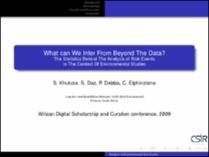 ResearchSpace
ResearchSpace
What can we infer from beyond the data? The statistics behind the analysis of risk events in the context of environmental studies
JavaScript is disabled for your browser. Some features of this site may not work without it.
- ResearchSpace
- →
- Research Publications/Outputs
- →
- Conference Publications
- →
- View Item
| dc.contributor.author |
Khuluse, S

|
|
| dc.contributor.author |
Das, Sonali

|
|
| dc.contributor.author |
Debba, Pravesh

|
|
| dc.contributor.author |
Elphinstone, C

|
|
| dc.date.accessioned | 2009-06-17T10:20:02Z | |
| dc.date.available | 2009-06-17T10:20:02Z | |
| dc.date.issued | 2009-04 | |
| dc.identifier.citation | Khuluse, S, Das, S, Debba, P and Elphinstone, C. 2009. What can we infer from beyond the data? The statistics behind the analysis of risk events in the context of environmental studies. African Digital Scholarship & Curation 2009, Pretoria, South Africa, 12-14 May 2009, pp 32 | en |
| dc.identifier.uri | http://hdl.handle.net/10204/3436 | |
| dc.description | African Digital Scholarship & Curation 2009, Pretoria, South Africa, 12-14 May 2009 | en |
| dc.description.abstract | When events occur outside the range of acceptable fluctuations, they may result in either (a) the events being more favourable than usual, or (b) the events being less favourable than usual. The latter has serious implications if their occurrences trigger a chain of subsequent negative events. Such events are termed `risk events'. Extreme Value Theory (EVT) is a tool that attempts to best estimate the probability of adversarial risk events. There are several environmental studies where extreme value methods have been used. In this paper, the behaviour of very high levels of the McArthur Fire Danger Index (FDI) at four sites in the Kruger National Park is described using the threshold exceedance approach in EVT. There is particular interest in whether there is dependence at high levels of the FDI series, seasonality and trend at each site. The authors will review how the model for threshold excesses, the Generalized Pareto distribution, has to be modified to incorporate these features and the effect this has on the parameter estimates | en |
| dc.language.iso | en | en |
| dc.subject | Environmental studies | en |
| dc.subject | Risk events | en |
| dc.subject | Probabilistic risk analysis | en |
| dc.subject | Fire danger indices | en |
| dc.subject | Statistical analysis | en |
| dc.subject | African Digital Scholarship & Curation 2009 | en |
| dc.subject | Extreme value theory | en |
| dc.subject | McArthur fire danger index | en |
| dc.title | What can we infer from beyond the data? The statistics behind the analysis of risk events in the context of environmental studies | en |
| dc.type | Conference Presentation | en |
| dc.identifier.apacitation | Khuluse, S., Das, S., Debba, P., & Elphinstone, C. (2009). What can we infer from beyond the data? The statistics behind the analysis of risk events in the context of environmental studies. http://hdl.handle.net/10204/3436 | en_ZA |
| dc.identifier.chicagocitation | Khuluse, S, Sonali Das, Pravesh Debba, and C Elphinstone. "What can we infer from beyond the data? The statistics behind the analysis of risk events in the context of environmental studies." (2009): http://hdl.handle.net/10204/3436 | en_ZA |
| dc.identifier.vancouvercitation | Khuluse S, Das S, Debba P, Elphinstone C, What can we infer from beyond the data? The statistics behind the analysis of risk events in the context of environmental studies; 2009. http://hdl.handle.net/10204/3436 . | en_ZA |
| dc.identifier.ris | TY - Conference Presentation AU - Khuluse, S AU - Das, Sonali AU - Debba, Pravesh AU - Elphinstone, C AB - When events occur outside the range of acceptable fluctuations, they may result in either (a) the events being more favourable than usual, or (b) the events being less favourable than usual. The latter has serious implications if their occurrences trigger a chain of subsequent negative events. Such events are termed `risk events'. Extreme Value Theory (EVT) is a tool that attempts to best estimate the probability of adversarial risk events. There are several environmental studies where extreme value methods have been used. In this paper, the behaviour of very high levels of the McArthur Fire Danger Index (FDI) at four sites in the Kruger National Park is described using the threshold exceedance approach in EVT. There is particular interest in whether there is dependence at high levels of the FDI series, seasonality and trend at each site. The authors will review how the model for threshold excesses, the Generalized Pareto distribution, has to be modified to incorporate these features and the effect this has on the parameter estimates DA - 2009-04 DB - ResearchSpace DP - CSIR KW - Environmental studies KW - Risk events KW - Probabilistic risk analysis KW - Fire danger indices KW - Statistical analysis KW - African Digital Scholarship & Curation 2009 KW - Extreme value theory KW - McArthur fire danger index LK - https://researchspace.csir.co.za PY - 2009 T1 - What can we infer from beyond the data? The statistics behind the analysis of risk events in the context of environmental studies TI - What can we infer from beyond the data? The statistics behind the analysis of risk events in the context of environmental studies UR - http://hdl.handle.net/10204/3436 ER - | en_ZA |





